.

"The Battering Ram has done its work". Eviction of Thomas Birmingham, tenant of the Vandeleur Estate, near Moyasta, County Clare. photo by Robert French, c. July 1888 (Lawrence Photograph Collection, National Library of Ireland)
Adonis: "houses left their walls behind"
They found people in bags:
a person
a person
a person
and the rest had no shapes and no names.
-- Are you mad? Please
A page in a book
bombs mirror themselves inside of it
prophecies and dust-proverbs mirror themselves inside of it
cloisters mirror themselves inside of it, a carpet made of the alphabet
disentangles thread by thread
falls on the face of the city, slipping out of the needles of memory.
A murderer in the city’s air, swimming through its wound --
its wound is a fall
that trembled to its name -- to the hemorrhage of its name
and all that surrounds us --
houses left their walls behind
Adonis (b. 1930): from Desert in Selected Poems (2010), translated by Khaled Mattawa

A relative looks at the demolished house of Palestinian Bahaa Mohammed Halil Allyan in the Arab east Jerusalem neighbourhood of Jabel Mukaber on Monday: photo by Ammar Awad/Reuters. 4 January 2015
bombs mirror themselves inside of it

A Yemeni inspects his family’s apartment destroyed by airstrikes carried out by the Saudi-led coalition targeting a neighborhood in Sanaa, Yemen on Monday: photo by Yahya Arhab/EPA, 4 January 2015

Saudi-led coalition announces end of cease-fire in #Yemen (AFP pic): image via China Xinhua News @XHNews, 2 January 2015
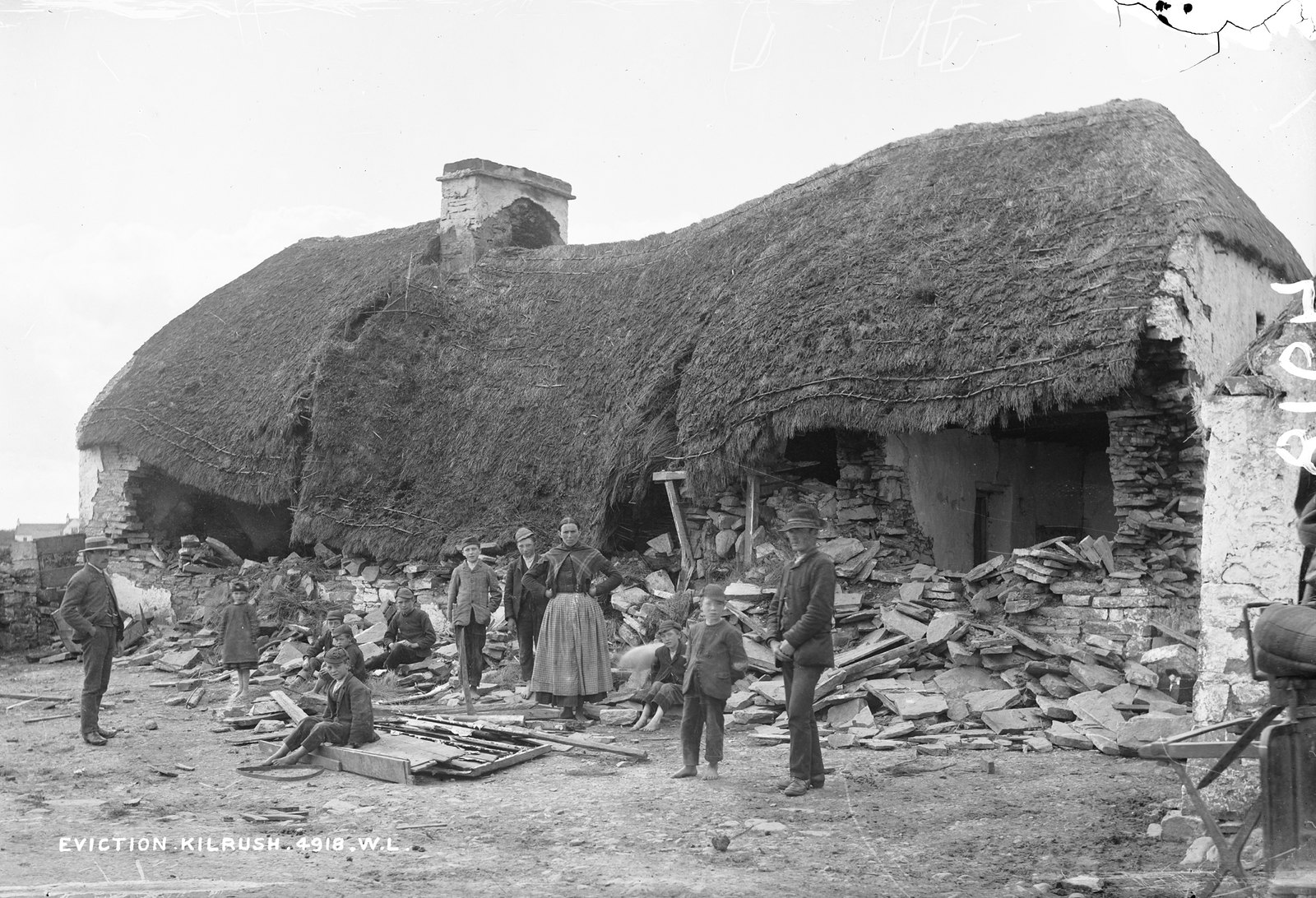
Mathias Magrath's house, Moyasta, County Clare, after destruction by the Battering Ram: photo by Robert French, 1888 (Lawrence Photograph Collection, National Library of Ireland)

A Yemeni inspects his family’s apartment destroyed by airstrikes carried out by the Saudi-led coalition targeting a neighborhood in Sanaa, Yemen on Monday: photo by Yahya Arhab/EPA, 4 January 2015
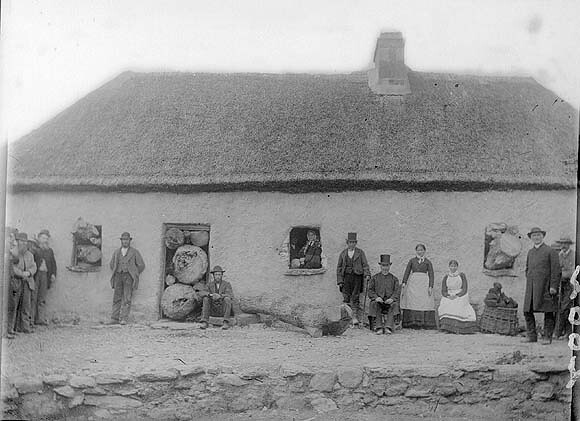
Widow Macnamara in her fortress. The home of eighty-year-old widow Margaret Macnamara, of Bodyke, County Clare, who was evicted on 2 June 1887.: photo by Henry Norman, 2 June 1887 (Eblana Photograph Collection, National Library of Ireland)
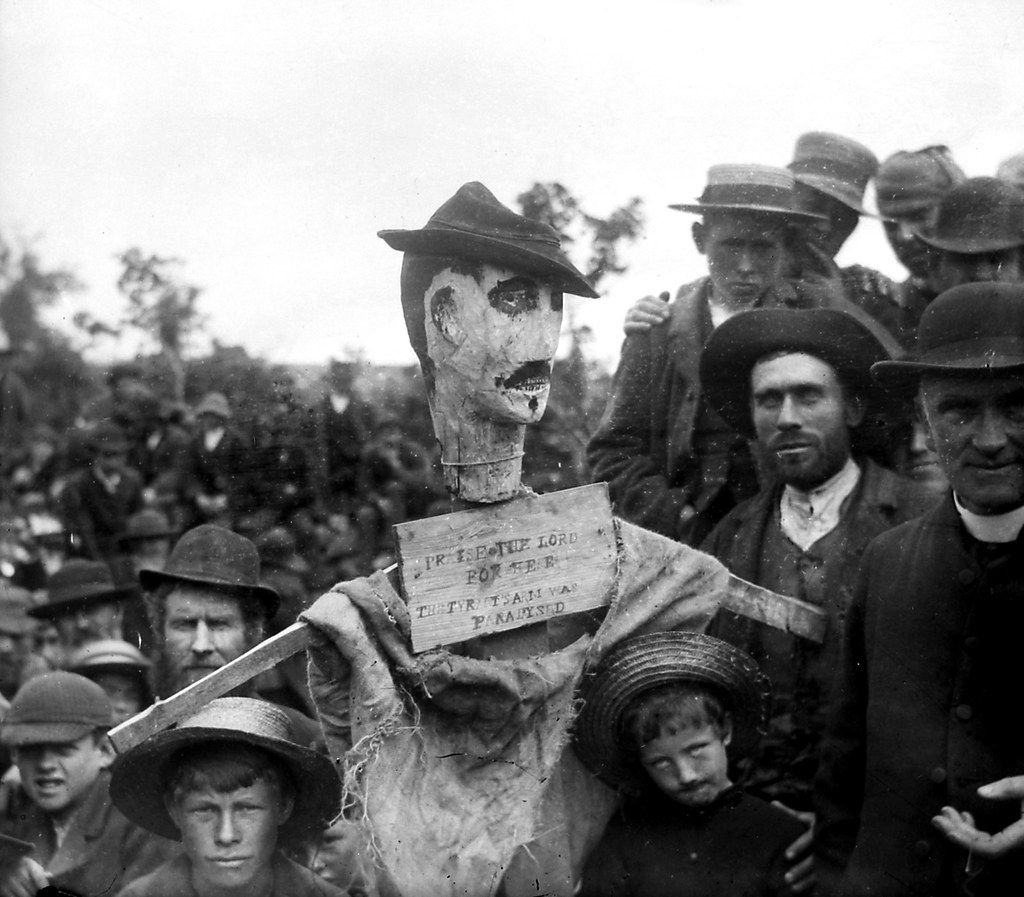
The Fire Brands, Bodyke, County Clare. The sign on the effigy reads: PRAISE THE LORD / FOR HERE / THE TYRANT'S ARM WAS / PARALYSED. Taken by Pall Mall Gazette journalist Henry Norman the day after Widow McNamara's eviction. The first sheriff, called McMahon, had turned up with a large force several days earlier but had an epileptic fit and withdrew. The tenants saw this as divine intervention and made this effigy of him.: photo by Henry Norman, Friday 5 June 1887 (Eblana Photograph Collection, National Library of Ireland)

A relative looks at the demolished house of Palestinian Bahaa Allyan in Jabel Mukaber: photo by Ammar Awad/Reuters, 4 January 2015
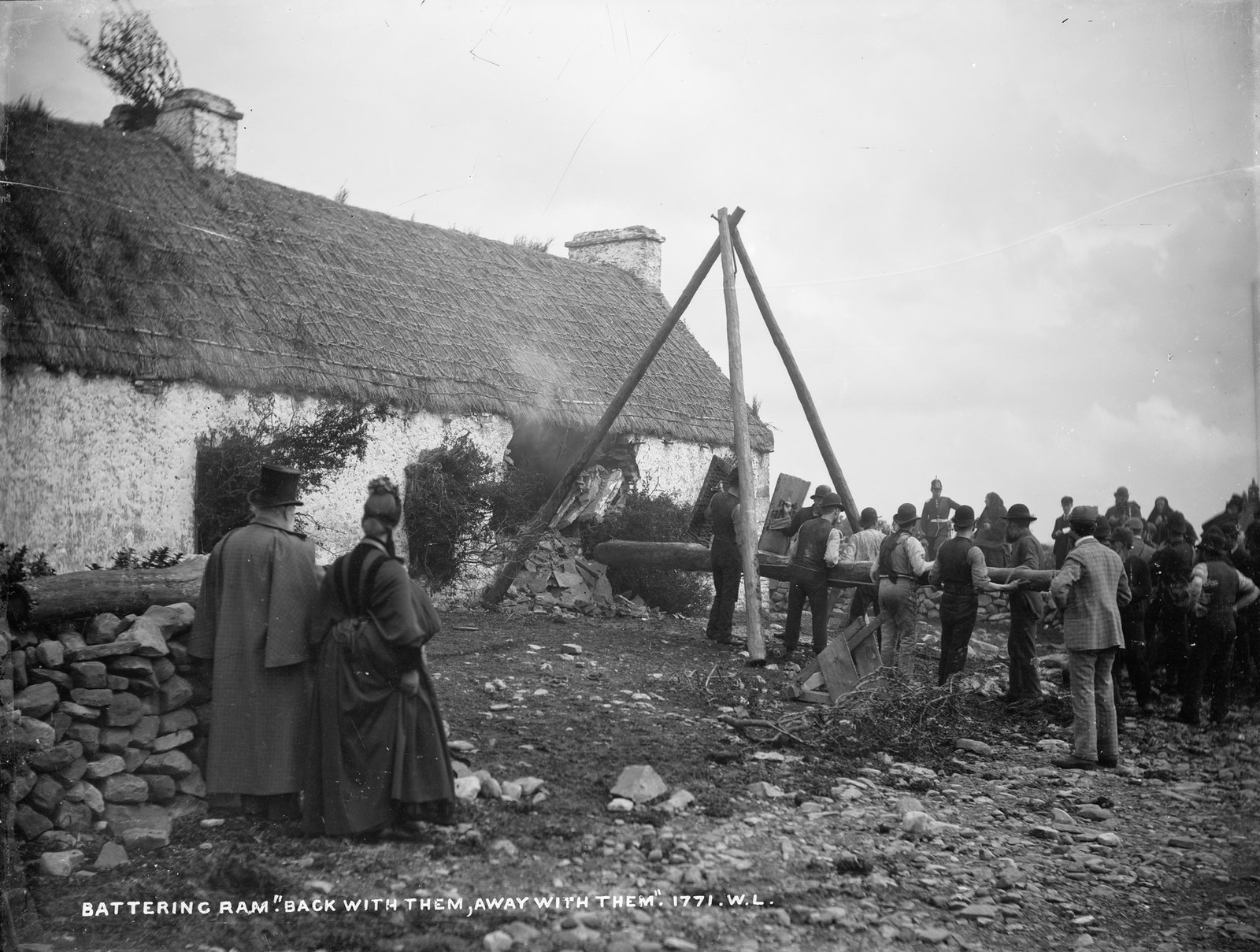
Battering Ram. "Back with them, away with them". Eviction of Thomas Birmingham, tenant of the Vandeleur Estate, near Moyasta, County Clare. photo by Robert French, 1888 (Lawrence Photograph Collection, National Library of Ireland)
A relative looks at the demolished house of Palestinian Bahaa
Mohammed Halil Allyan in the Arab east Jerusalem neighbourhood of Jabel
Mukaber on Monday: photo by Ammar Awad/Reuters. 4 January 2015
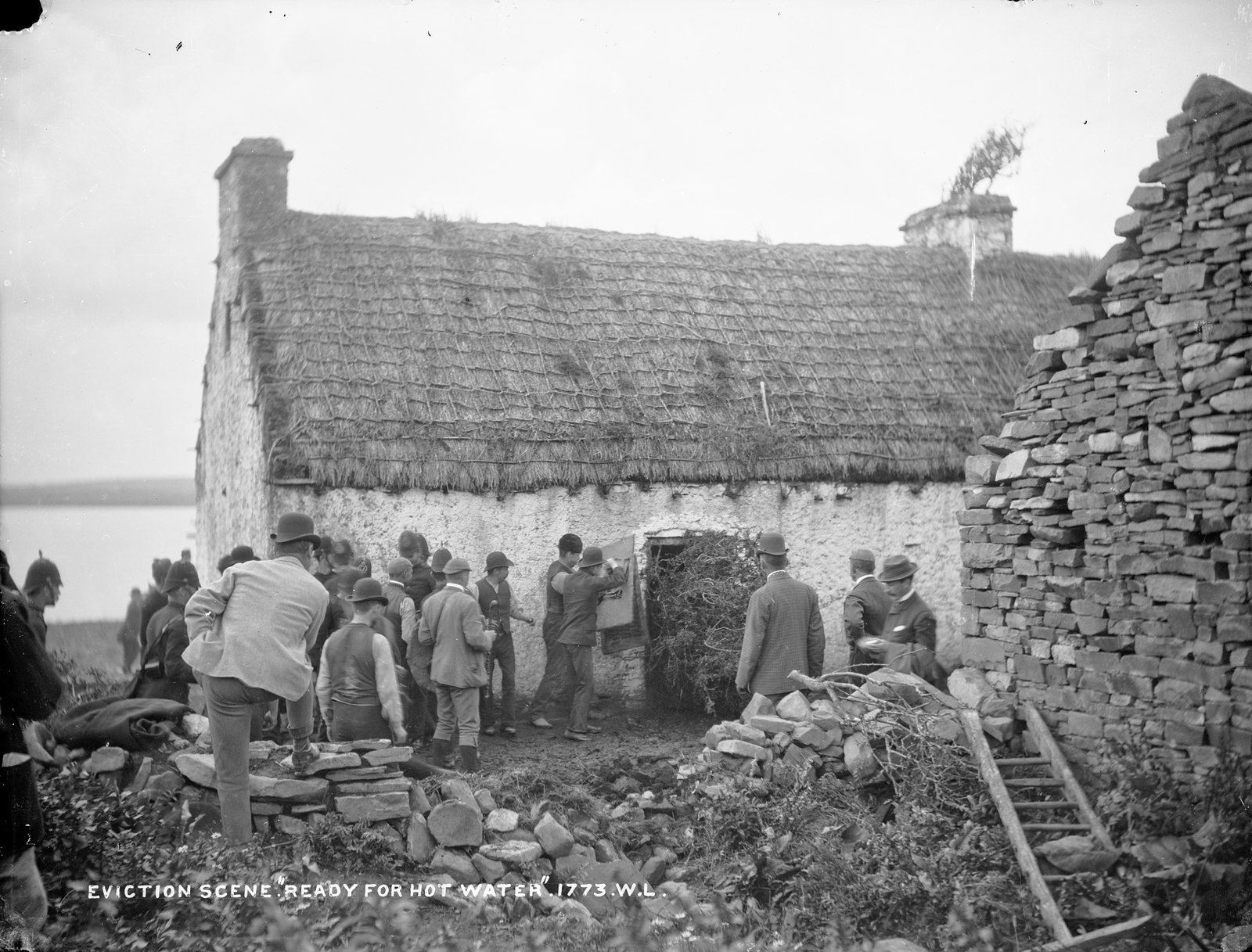
Eviction scene. "Ready for hot water". Eviction of Thomas Birmingham, tenant of the Vandeleur Estate, near Moyasta, County Clare. photo by Robert French, c. July 1888 (Lawrence Photograph Collection, National Library of Ireland)
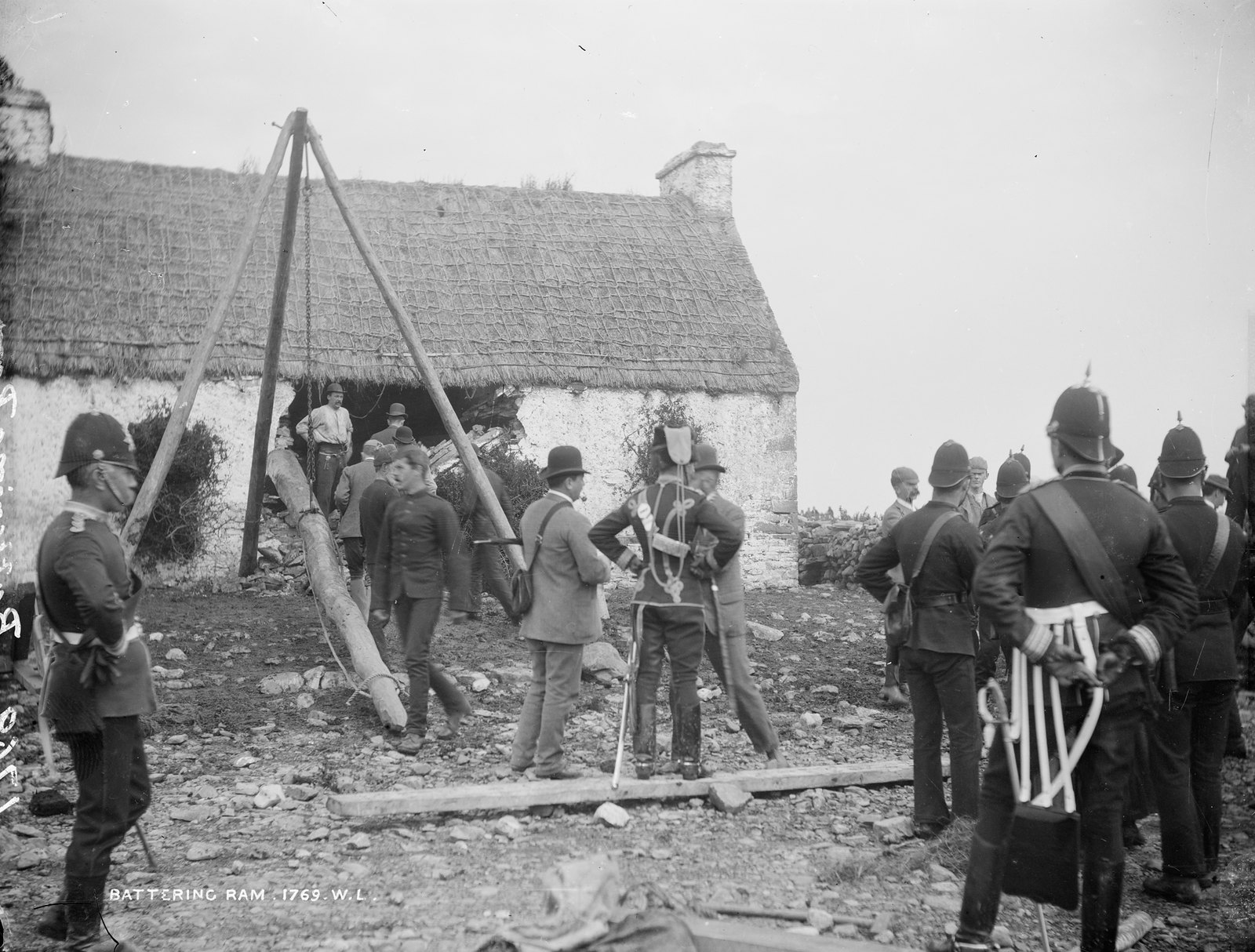
T. Birmingham's house, Moyasta, County Clare, with Battering Ram and soldiers outside: photo by Robert French, c. July 1888 (Lawrence Photograph Collection, National Library of Ireland)
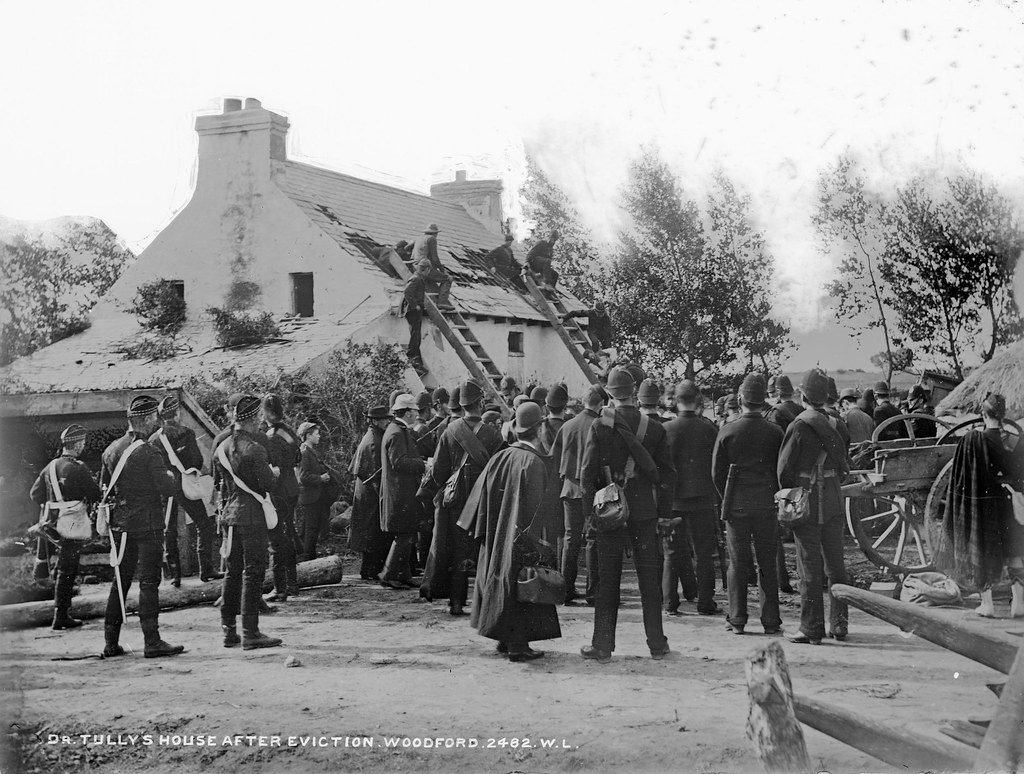
Dr
Tully's House. A eviction on land of the Marquis of Clanricarde at
Woodford, County Galway. Farmer and boat builder Francis Tully, known
locally as "Dr Tully", was an activist for the Plan of Campaign in Galway. The Plan of Campaign was an attempt
to gain lower rents through collective bargaining because
prices on agricultural exports had fallen dramatically in the 1880s.
Maud Gonne agitated for change by projecting images like this one onto a building in Parnell Square, Dublin: photographer unknown, 1 September 1888 (National Library of Ireland)
"The only serious attempt at resisting the execution of the law was made by "Dr." Tully, one of the leading local "agitators," to the tendency of whose harangues judicial reference was made during the investigation into the case of Mr. Wilfrid Blunt. Tully had a holding of seventeen acres at a rent of L2, 10s., the Government valuation being L4. He earned a good livelihood as a boat-builder, and he had put up a slated house on his holding. But in November 1884 he chose to stop paying the very low rent at which he held his place, and he has paid no rent since that time. As is stated in a footnote on page 153, vol. ii. of this book, a decree was granted against Tully by Judge Henn for three years' rent due in May 1887, and his equity of redemption having expired July 9, 1888, this recourse was had to the law against him."
The collapse of the resistance at this central point was followed by a general surrender.
"The only serious attempt at resisting the execution of the law was made by "Dr." Tully, one of the leading local "agitators," to the tendency of whose harangues judicial reference was made during the investigation into the case of Mr. Wilfrid Blunt. Tully had a holding of seventeen acres at a rent of L2, 10s., the Government valuation being L4. He earned a good livelihood as a boat-builder, and he had put up a slated house on his holding. But in November 1884 he chose to stop paying the very low rent at which he held his place, and he has paid no rent since that time. As is stated in a footnote on page 153, vol. ii. of this book, a decree was granted against Tully by Judge Henn for three years' rent due in May 1887, and his equity of redemption having expired July 9, 1888, this recourse was had to the law against him."
As
the leading spirit of the agitation, Tully had put a garrison into his
house of twelve men and two women. He had dug a ditch around it, taken
out the window-sashes, filled up the casements and the doorways with
stones and trunks of trees. Portholes had been pierced under the roof,
through which the defenders might thrust red-hot pikes, pitchforks, and
other weapons, and empty pails of boiling water upon the assailants. A
brief parley took place. Tully refused to make any offer of a settlement
unless the agent would agree to reinstate all the evicted tenants, to
which Mr. Tener replied that he would recognise no "combination," but
was ready to deal with every tenant fairly and individually. Finally the
Sheriff ordered his men to take the place. Ladders were planted, and
while some of the constables, under the protection of a shield covered
with zinc, a sort of Roman _testudo_, worked at removing the earthern
ramparts, others nimbly climbed to the roof and began to break in from
above. In their excitement the garrison helped this forward by breaking
holes through the roof themselves to get at the attacking party, and in
about twenty minutes the fortress was captured, and the inmates were
prisoners. Two constables were burned by the red-hot pikes, the gun of
another was broken to pieces by a huge stone, and a fourth was slightly
wounded by a fork. One of the defenders got a sword-cut; and Tully was
brought forth as one too severely wounded to walk. Upon investigation,
however, the surgeon refused to certify that he was unable to undergo
the ordinary imprisonment in such cases made and provided.
The collapse of the resistance at this central point was followed by a general surrender.
After
the capture of Tully's house, Mr. Tener writes to me, "I found it being
gutted by his family, who would have carried it away piecemeal. They
had already taken away the flooring of one of the rooms." Thereupon Mr.
Tener had the house pulled down, with the result of seeing a statement
made in a leading Nationalist paper that he was "evicting the tenants
and pulling down their houses."
Ireland Under Coercion (2nd ed.) (2 of 2) (1888)
He wasn't really a doctor but was called this because he prescribed "leaden pills" (bullets) for greedy landlords...
(Information courtesy of an insomniac researcher on the NLI website, Jo Hedwig Teeuwisse, 2012)
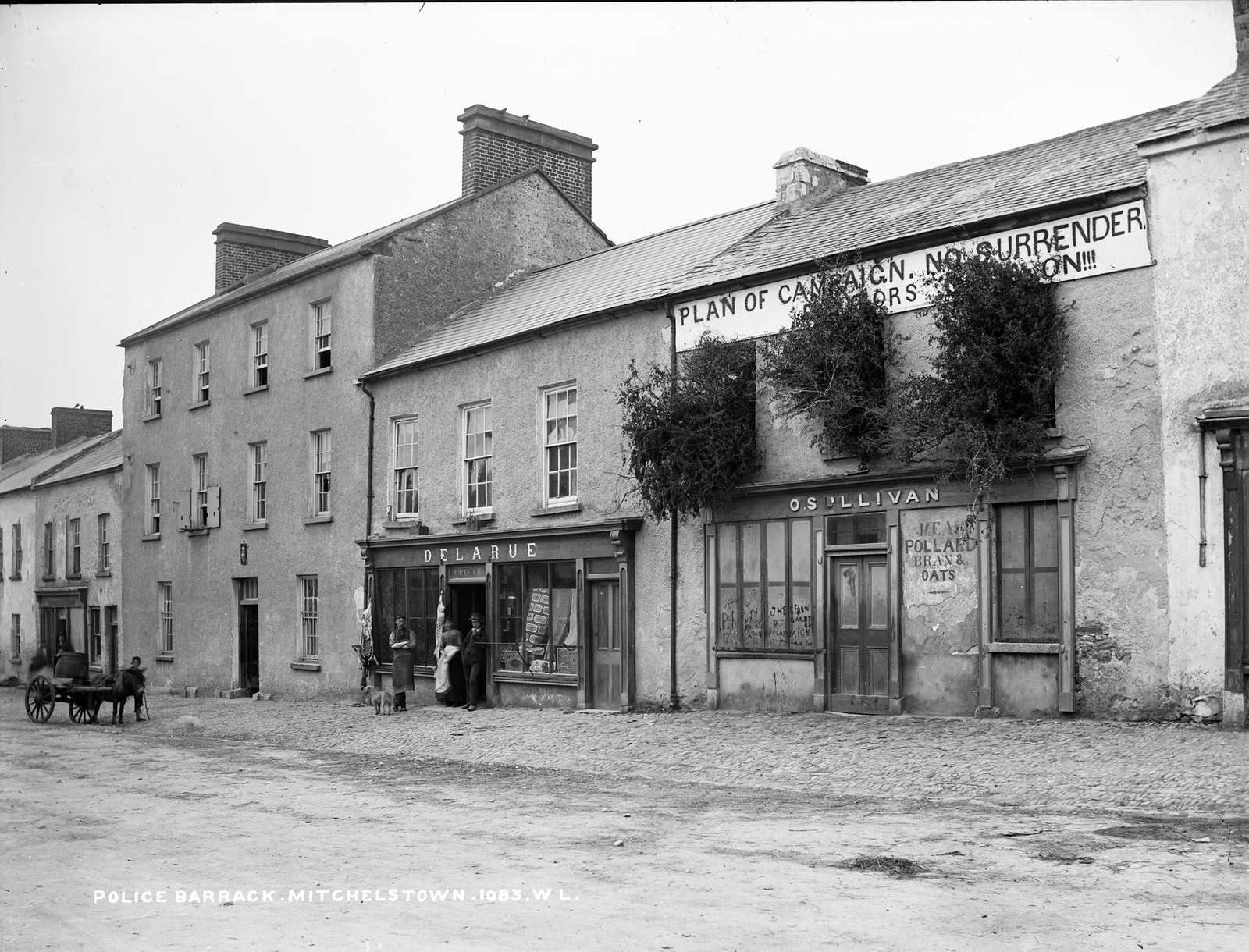
Mitchelstown Eviction Resistance at O'Sullivan's, County Cork. The plan of the campaign was an attempt to gain lower rents through collective bargaining because prices on agricultural exports had fallen dramatically in the 1880s: photographer unknown, c. June 1887 (National Library of Ireland)






6 comments:
evokes a lot of memory in the blood Tom, my father's father Michael (I'm obviously named after him) grew up in a thatch roof cottage more humble than the ones in the photos above and which was till standing when I first visited the place in County Galway, and I heard all about the evictions and tumbling etc. of the ancient cottages...resonating as the poem and other photos do with the similar suffering still going on in this world...ack...
This is a great & telling post, Tom, reminding us of the universality of oppression. I love Dr. Tully, though I hope my own "equity of redemption" never expires. It seems especially Irish for the report on the siege of the house to note that someone was "slightly wounded by a fork."
After all the rent-raising and huffing and puffing, a dominating invading power establishing its hegemony over the land of others grows impatient, and likes to knock down the houses of the natives by overwhelming force, just to show who's boss, and who's got the biggest, brassiest bollocks...
After demolishing the house of Palestinian Bahaa Mohammed Halil Allyan in the Arab east Jerusalem neighbourhood of Jabel Mukaber on Monday, the IOF tagged a neighboring house for imminent demolition... thoughtful monsters that they are... and the Saudis would like us to feel secure in the knowledge they'll always have another US-made bomb or missile to share with the people of Yemen.
Carrion birds of a feather with the Brit occupiers of Ireland.
Here I've concentrated on the infamous Vandeleur evictions.
A bit of information:
There were 21 evictions on the Vandeleur estate in Kilrush in July 1888. These evictions became an international incident. It was reported that the eviction party consisted of 20 bailiffs, with axes, crowbars, ladders, and battering rams. They were accompanied by a troop of hussars, 2 companies of soldiers, and about 250 policemen.
The landlord at the time was Hector Vandeleur "the worse type of absentee land lord". He had inherited the property in 1881 but only visited it once in 1882.
A Canadian-born American of Irish descent, Edward Joseph O'Shaughnessy, his wife, Maggie, and sister-in-law, Ellen Dunn, witnessed the evictions at the Vandeleur estate in Kilrush in July 1888.
Hector Stewart Vandeleur, Landlord:
Vanderleur, Capt. Hector Stewart, J. P.: Lord Lieutenant County Clare, eldest son of Colonel Crofton Moore Vandeleur, M. P. (died 1881) and Lady Grace Toler daughter of 2nd Earl of Norbury,; born 1836 married 1867 Charlotte, eldest daughter of W. O. Forster of Apley Park, Salop. Education Eaton. Fomerly in Rifle Brigade: High Sheriff County Clare 1873. Address 50 Rutland Gate, S. w..; Cahiracon, County Clare, Clubs Carlton, Arthurs - (Who's Who, 1907)
In 1851 Hector Vandeleur was listed as a student at Eton.
In 1871 Hector S Vanderleur an his wife and son, Cecil age 1 were listed in London with: a butler, a cook, a kitchen maid, a footman, a nurse a housemaid and a nurse.
In the 1881 census Hector S Vandeleur, born county Clare Ireland, his wife, Charlotte and a daughter, Norah age three, were listed in St George London with: a cook, a housemaid, an under housemaid, a footman, a kitchen main, a lady's maid, and a Swiss nurse.
In 1891 Hector his wife and two children, Grace age 19 and Alexander 7, were listed in London with: 9 servants: a butler, a cook 2 lady's maids, 2 housemaids, a footman, a kitchenmaid, and a scullery maid
In September 1901 C. F. Seymore Vandeleur, the son of Hector S. Vandeleur of Kilrush Ireland, born 1869 educated at Eton, was killed during the Boer War when a train blew up near Waterval South Africa.
In 1906 Hector Vandeleur owned at least 902 untenanted acres of land in Kilrush parish.
Hector S Vandeleur died in 1909 leaving "effects" valued at 6,114 pounds.
Edward Joseph O'Shaughnessy was an American witness to the Evictions at the Vandeleur Estate in 1888.
E. J. O'Shaughnessy, a well known Irish Nationalist, with his wife and sister-in-law went to Europe in April 1888. They traveled in Germany, France and Italy, where they had a private audience with the pope. Then they headed to Ireland where they "went to the evictions" and observed the destruction of the cottages with battering rams for "some three or four miles around Kilrush". "When the procession moved to another beat it looked like a huge funeral with its long line of military in front, and outside carts following, the people on foot bring up the rear, besides, thousands crossing the fields". Only the reporters and O'Shaughnessy and his companions were allowed inside "the lines of steel". No other sympathisers were allowed within a half mile of the site. The chapel bell tolled endlessly and all the stores in Kilrush were shuttered. O'Shaughnessy said that Ireland was the "worst looking, most wretched, most decayed, most poverty stricken and apparently the most God-forsaken county" he had ever seen. (Quotes from The True Witness and Catholic Chronicle, October 9, 1889)
As battering rams were used to break the walls of the cottages, most inhabitants barricaded their doors and widows and resisted "as far as they were able". One method was to boil water and throw it at the evictors as they came though the hole that had been rammed in the wall. When smoke was seen coming from the chimney the evictors would climb on the roof and stuff the chimney with straw in an attempt to smoke the tenants out.
The tenants did not know who would be the next to be evicted out of over a hundred cabins scattered over an area of nine miles.
Captain Vandererleur turned his home, the Kilrush house, into a camp to accommodate the infantry and constabulary involved in the evictions.
"During the evictions all business was suspended in Kilrush,the shops were closed and the widows shutters put up, men left their work in the fields and the bell of the parish church tolled mournfully and unceasingly as if for a funeral."
The Vandeleur property consisted of about 20,000 aceres. Disputes of rent rates resulted in 86 ejectment decrees.
"The holdings ranged from fifteen acres to fifty or sixty. The houses were well built with stone, and with three or four rooms; the land apparently well cultivated. The families of many of the tenants had been in possession of these farms for generations. The houses had been built and improvements of every kind had been effected by them. Their tenants' interest was at least equal to that of the landlord. They had been selected for attack as those most solvent and best able to pay in the opinion of the agent."
Incidents of Coercion: A Journal of Visits to Ireland in 1882 and 1888 By George Shaw-Lefevre Baron Eversley
All of the tenants' furnishings were turned out of the houses and in some case the buildings were totally destroyed. The tenants (except for the women) were arrested and remanded to prison to await trail at Kilrush. Twenty-two tenants were evicted.
In September 1889 Tom Bermingham and Pat McGrath, two of the Kilrush evicted tenants, were still in prison. Tom Bermingham was sentenced to two sentences of 6 months each. (Journal of the Home Rule Union, Volume 1)
__
The capsule history given here, along with further appalling documentation of the subjugation and terrorising of Irish tenants by British absentee landowners, comes from:
Evictions
Well, those were of course maids not mains, windows not widows, but I thought, Let it be -- unsponsored research, the one relatively trustworthy kind.
Also, this bit --
The tenants did not know who would be the next to be evicted out of over a hundred cabins scattered over an area of nine miles.
-- is a reminder that there is an almost universal quality to the special kind of terror now dolloped out of the sky, in the new kind of warfare, where anybody on the ground wearing white might well be marked for instant termination of the sort gleefully practised in electronic video toy simulation, much as only last week neath the Yule log by those cute great grand kids, oh crikey well now aren't they the most adorable... .
Hard for the mind of the victim on the ground or in the cottage to rest easy, mid such anxious contingency.
Post a Comment